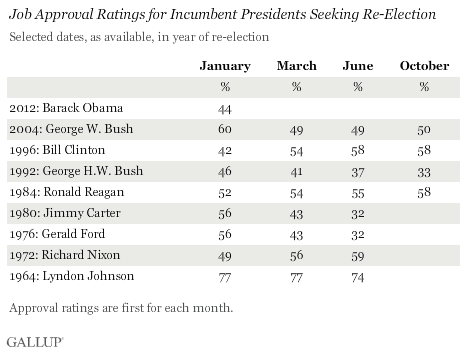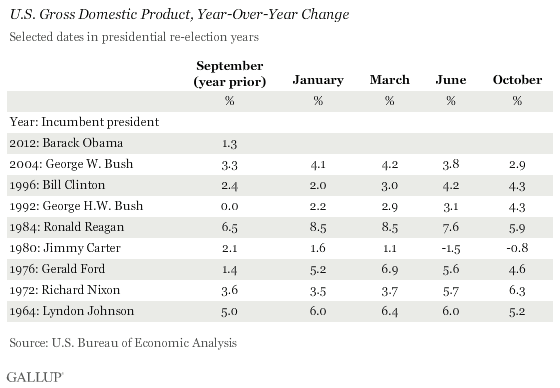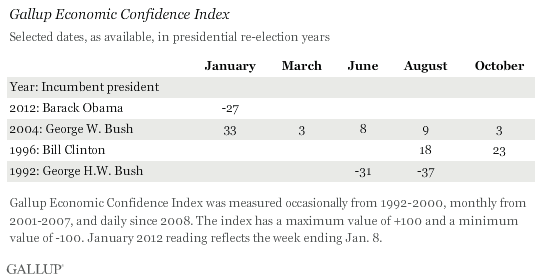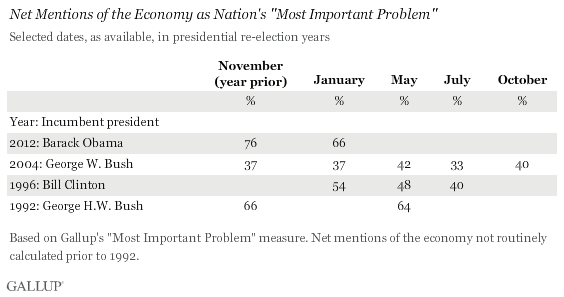PRINCETON, NJ -- The U.S. political and economic environment at the start of 2012 is a challenging one for President Barack Obama as he seeks re-election. However, Gallup trends suggest that it is too soon to make any firm predictions about the outcome.
The following is a rundown of where some key indicators stand in January, and how trends today compare to years when previous incumbents sought re-election.
Presidential Job Approval
Obama's job approval rating has averaged 44% in Gallup Daily tracking since the start of January. That is below the approval rating of seven out of eight previous incumbents at a comparable point in their presidencies. It exceeds the ratings of only one -- Bill Clinton -- in early January 1996.
With five of the eight former presidents who sought re-election -- George W. Bush, Bill Clinton, Ronald Reagan, Richard Nixon, and Lyndon Johnson -- winning a second term, and three -- George H.W. Bush, Jimmy Carter, and Gerald Ford -- losing, the January approval ratings do not appear to be strongly predictive of the election outcome.
However, by March of the re-election year, approval ratings for all of the prior presidents largely portended their fate. Ford's, Carter's, and the elder Bush's March ratings were all well below 50%, while Clinton's, Reagan's, Nixon's, and Johnson's were above that mark. George W. Bush's rating was 49%, right on the cusp of the level Gallup considers determinant for re-election.

U.S. Satisfaction
Americans' overall satisfaction with the direction of the country has varied considerably over the three-plus decades Gallup has measured it, from a low of 7% in October 2008 to a high of 71% in February 1999. The current 18% satisfied at the start of January is among the lowest Gallup has found during a presidential re-election year, with lower ratings occurring only in 1992, the year George H.W. Bush was defeated.
Although a mere 24% of Americans were satisfied in January 1996, this rose to 41% by March and was 39% in October, right before Clinton was re-elected. Satisfaction was at about the same level -- 41% -- in October 2004, in advance of George W. Bush's re-election, suggesting 40% is a safe zone for presidents on this indicator.
As with presidential job approval, the aforementioned 1996 trend during Clinton's re-election year shows that presidents who start the year with U.S. satisfaction quite low can still win if the number improves by March. Whether the upturn can happen later in the year is unclear, in part because there are no Gallup trends on this measure for incumbent re-election years prior to 1984.

Unemployment
The U.S. unemployment rate is not destiny for an incumbent president, but as political scientist Tom Holbrook has concluded, the direction and rate of change in unemployment may be.
With the nation's unemployment rate registering 8.5% in December, Obama is in the company of Ford, Carter, Reagan, and George H.W. Bush -- all presidents who served when unemployment exceeded 7% in the year leading up to their re-election bid.

For the most part, the difference between successful and unsuccessful presidents when it comes to unemployment is momentum. Unemployment was flat or increasing under Carter and George H.W. Bush, and they both lost. Unemployment was declining under Reagan, and he won.
The pattern is more complex with Ford, as unemployment fell from 8.2% at the end of 1975 to 7.4% in May 1976, but then increased to 7.8% in July and August.
Gross Domestic Product
Holbrook puts more stock in the direction of gross domestic product as a predictor of presidential elections. U.S. GDP for the fourth quarter of 2011 is not yet available, but the third-quarter results are something for Obama's re-election team to be concerned about. The economy grew at 1.3% year-over-year in September, below the 2.4% to 6.5% range seen in the comparable month for the prior five successful incumbents, and on par with or below the rate seen for two of the three who lost.
More broadly, GDP growth was 3.5% or better with few exceptions in 1964, 1972, 1984, and 2004, and improved considerably over the course of 1996, and the presidents seeking re-election in those years all won. GDP growth was tepid in 1980 and well into 1992, and both presidents running for re-election in those years lost.
Again, Ford is an outlier, representing the only president who was in office at a time of healthy GDP growth in his re-election year, yet who lost the election.

Economic Confidence
As George H.W. Bush learned in 1992, it is not just the condition of the economy that matters when it comes to being re-elected, it's what Americans think of the economy. In 1992, Gallup's Economic Confidence Index -- a summary of whether Americans have mostly positive or negative views of the economy and its direction -- looked bleak, registering -31 in June and -37 in August. That contrasts with higher Gallup Economic Confidence Index values in two years in which presidents were re-elected, ranging between +1 and +23 at various points in 1996, and -3 and +33 in 2004.
Economic confidence has shown marked improvement over the past few months, but it still stands at -27 in early January. Obama's chances of being re-elected could hinge on whether this measure continues to improve, and if so, by how much.

Most Important Problem
Another valuable indication of Americans' concern about the economy comes from Gallup's Most Important Problem data. Two-thirds of Americans in January 2012 mention some aspect of the economy as the nation's most important problem. This is higher than the 54% "net economic" mentions in January 1996 under Clinton and the 37% in January 2004 under George W. Bush.
Public mentions of the economy fell to 40% by July 1996 in advance of Clinton's re-election, and remained at about the 37% level in 2004 before George W. Bush's win. By contrast, the current mentions of economic issues are comparable to the 66% recorded in November 1991 and 64% in May 1992 under George H.W. Bush, who was defeated.

Bottom Line
Americans' current evaluation of the president's job performance, their satisfaction with the direction of the country, and their ratings of the economy are all on the lower end of what Gallup has found at or near the start of previous years when an incumbent president sought re-election. While these comparisons are not auspicious for Obama's re-election, a broader view of how these ratings have changed over the course of previous presidential election years suggests it is not too late for the numbers to shift in Obama's favor. The same can also be said of the nation's unemployment rate and GDP.
The trend points are limited -- there are only eight past elections to review. But on the basis of the available data, it appears that Obama's March approval rating and U.S. satisfaction level could be more useful than January's in portending the election outcome. By March, it should also be clearer whether unemployment is continuing the swift decline seen since September or if that momentum has stalled, and whether the nation's economy is picking up speed.
Professor Chris Wlezien of Temple University may give the president a little more time than that to turn things around, as he has determined that economic indicators affect voter preferences in the year leading up to the election, although particularly through June. Changes in the economy after that have less impact, in part because of the lag times in reporting and because voters' opinions of the candidates are hardening.
Regardless, it's clear that today's numbers present challenges for Obama to overcome, but that he has time to do so. Given that, we can expect a strong focus on the economy in his State of the Union address later this month, and more efforts like last week's elevation of the Small Business Administration to a cabinet-level agency -- decisions that signal Obama is taking a jobs-oriented approach to repairing the economy.
